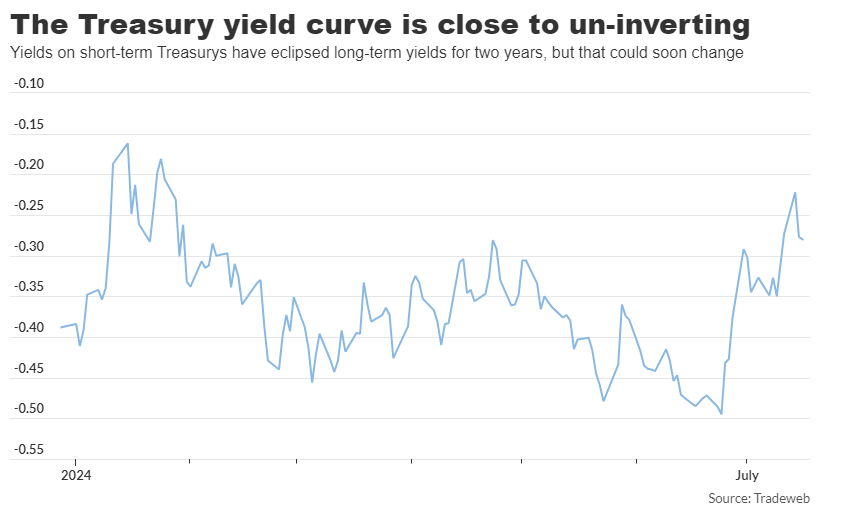Treasury Market Turbulence: Are Stocks on the Brink of a Downturn?
An inverted Treasury yield curve is typically seen as a harbinger of recession, although the U.S. economy has held up so far.
An inverted Treasury yield curve is often viewed as a signal of an impending recession. But does the curve’s return to normalcy signal an all-clear for the market? History suggests otherwise. According to Tom Essaye, a former Merrill Lynch trader and founder of Sevens Report Research, the reversal of a yield-curve inversion has frequently signaled upcoming economic and stock market troubles.
This potential shift is significant as the gap between short-term and long-term Treasury yields has narrowed recently. On Monday, the gap between the 2-year and 30-year yields briefly turned positive for the first time since January, according to Dow Jones Market Data. Additionally, the gap between the 2-year and 10-year yields reached its narrowest point in a similar timeframe.

Analysts at Macquarie attribute these bond movements to the broader “Trump trade,” which encompasses higher tariffs, tax cuts, and restrictive immigration policies proposed by former President Donald Trump. They argue these measures could revive inflation and push up long-term bond yields.
Since 1998, the spread between the 2-year and 10-year Treasury yields has inverted six times, including the current episode that began in July 2022. Previous inversions occurred in June 1998, February 2000, January 2006, June 2006, and August 2019. Only three of these instances, including the current one, saw the yield curve remain inverted for a significant period, with the others occurring in February 2000 and June 2006.
In both cases, the un-inversion preceded stock market turbulence. When the 2s10s spread returned to positive territory on Dec. 29, 2000, the S&P 500 traded around 1,320 but then declined for 22 months, bottoming at around 785 in October 2002. Similarly, when the spread returned to positive on June 6, 2007, the S&P 500 was at 1,517, but the index fell over the next 21 months as the housing market collapse triggered the 2008 financial crisis, bottoming out in March 2009. It took four years for investors to recoup these losses.
Essaye explains that when the 2s10s spread turns positive, it usually means the 2-year Treasury yield is dropping quickly as investors anticipate aggressive rate cuts. These cuts typically happen because the Federal Reserve is worried about economic growth. This is currently happening, with the market pricing in a 100% chance of rate cuts in September and December, and a growing likelihood of a third cut this year.
Despite warnings of an imminent recession due to the Federal Reserve’s aggressive rate hikes, the U.S. economy has shown resilience. Recent data hints at slowing growth and a softening labor market, but a stronger-than-expected retail sales report on Tuesday offered some reassurance.
Many stock-market experts doubt a recession is imminent, believing that Fed Chair Jerome Powell might achieve a soft landing by cutting rates later this year.
Early Wednesday, Treasury yields were rising, with the 2-year up 4 basis points at 4.47% and the 10-year up 2 basis points at 4.18%. Bond yields move inversely to prices. Meanwhile, U.S. stocks opened mostly lower, with a sharp selloff in technology stocks. The S&P 500 was down 1% at 5,610, the Nasdaq Composite down 1.7% at 18,186, and the Dow Jones Industrial Average traded about 30 points, or 0.1%, higher at 40,989.




